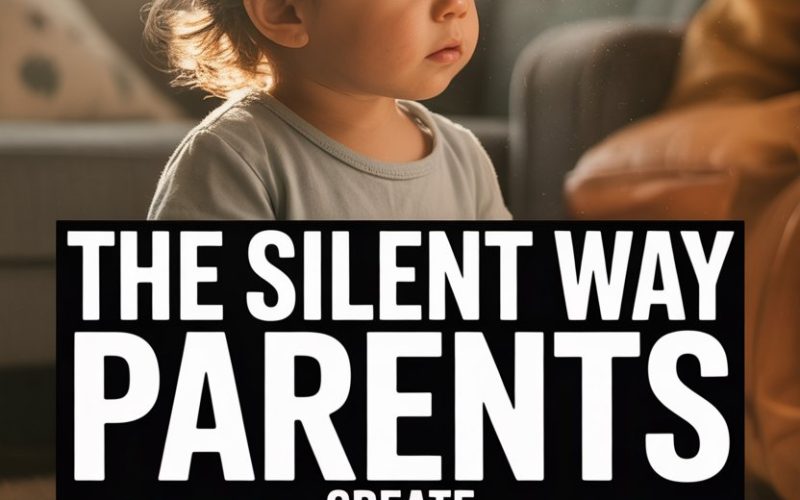Some things are loud and obvious: toddlers going full Tasmanian Devil in the supermarket, teens slamming doors, or that dreadful “Mum, I’m bored” right as you sit down with a cuppa.
But anxiety in kids? Sometimes it sneaks in quieter than a mouse at midnight—often helped along by well-meaning parents who’d never dream they’re part of the problem.
Here’s how anxiety tiptoes into our kids’ lives, often through the things we don’t say, don’t do, or even don’t notice.
If you’re a parent who’d never let your little one cross the street without holding your hand—but still finds yourself up at night fretting over their fretting—pull up a chair.
Let’s talk about the silent way anxious kids are made, and what you can do to short-circuit the cycle.
Anxiety Is Contagious—And Not Just From Germs
Imagine anxiety as glitter: you don’t have to dump a whole bottle on your child for them to end up sparkly. Just a little here and there, and suddenly, there’s glitter everywhere—on the dog, in the pram, probably in your sandwich.
Psychologists call this “emotional contagion”—the way parents’ stress and anxiety rub off on their children, even without a word being spoken.
When grown-ups carry tension like it’s a designer handbag—every sigh, every white-knuckled grip on the steering wheel, every whispered fret about “what if”—kids soak it up.
In one study, anxious parents were more likely to have anxious children, simply because little ones are wired to look to adults for cues on how the world works. If you’re constantly expecting disaster, they start to expect it too.
Silent Safety Signals—and the Problem With Bubble-Wrapping
Most parents would walk barefoot through Legoland to keep their kids safe. That’s love. But sometimes, the effort to protect can get a bit, well, overzealous.
When every risk is headed off at the pass and every potential fall is padded six ways from Sunday, children receive a not-so-subtle message: “The world is dangerous, and you can’t handle it.”
Here’s the kicker: children learn courage by doing—by handling situations that are a little bit tricky. When every scary thing is banished, they don’t learn that they can cope, only that they mustn’t try.
In fact, researchers at Macquarie University found that avoidance (both from parents and kids) plays a huge role in keeping anxiety alive.
Words Left Unsaid Speak the Loudest
Sometimes, it’s what we don’t say that leaves the deepest mark. When parents avoid tough topics—grief, worries, big feelings—kids quickly learn that these things are off-limits.
Silence becomes shame, and every anxious little thought gets bottled up.
Consider the classic example: a child worries about monsters under the bed. If a parent brushes it off or changes the subject, instead of talking it through, the message is clear—“We don’t talk about fears.”
That fear doesn’t disappear; it just finds a darker corner. Experts at the Child Mind Institute agree: honest, age-appropriate conversations about worries are vital.
Parental Perfectionism: The Stress That Trickle-Downs
Ever caught yourself trying to juggle every plate perfectly—Nut-free, gluten-free packed lunches, homemade costumes, a spotless house—without ever letting the mask slip?
Kids pick up on the pressure, even if you’re quietly grinding your teeth behind a smile.
There’s strong evidence that parental perfectionism is linked to anxious feelings in children. When mistakes aren’t okay for adults, children start to believe mistakes aren’t okay for them, either.
Suddenly, life’s a performance, and the stakes feel sky-high. Cue nervous stomachaches, sleepless nights, and tears over a single wrong answer.
The Surprising Power of Your Poker Face
Children are tiny experts at reading faces. Before they can talk, they’ve memorised every twitch and eyebrow raise you’ve got.
If you flinch at every scraped knee or gasp at loud noises, your child is right there, clocking your every reaction.
Studies show that when parents react to stress or risk with visible fear or panic, children quickly learn to do the same.
On the flip side, a calm (or at least convincingly calm!) demeanour can send a powerful message: “We can handle this.” Want to see this in action?
Next time your little one trips, try a casual “Oops, up you get!” instead of the dramatic rush to rescue. You might be surprised.
How Over-Scheduling Makes Tiny Stress Balls
Modern family calendars look less like “Little House on the Prairie” and more like the launch schedule for NASA. Piano lessons, football, Mandarin, Kumon, drama, playdates—sometimes all in one afternoon.
While enrichment is wonderful, a jam-packed life leaves precious little room for downtime, mistakes, or the gentle art of getting bored.
Anxiety loves a busy mind. When kids have no breathing space, small worries can snowball into major stress. Psychologist Dr. Alvin Rosenfeld calls today’s over-scheduling a hidden driver of stress and emotional overload.
Quiet Comparison—The Social Media Trap
The playground used to be where parents compared notes. Now, it’s Instagram, Facebook, or WhatsApp mums’ groups, where everyone’s child seems to be reciting Shakespeare at four and eating quinoa for breakfast.
Even if you never say a word about it, your own stress about measuring up can be palpable at home.
Children sense when adults are anxious about not being “enough.” Perfectionist comparison doesn’t have to be spoken—it’s written all over your face as you scroll. Kids want to please, to match, to live up. Cue anxiety, once again.
What Parents Can Do Tonight
Awareness is the first step. If you recognise yourself in any of these patterns, congratulations—welcome to the club. No one raises kids in a bubble (except maybe your mate Claire from NCT, but she’ll crack eventually).
Here’s what helps:
Model Imperfection—Gloriously
Messed up dinner? Forgot a permission slip? Show your kids it happens, and that the world doesn’t end. Laugh at yourself sometimes. Say “I tried something new today and it didn’t work out—I’ll try again.”
Turns out, resilience is caught, not taught.
Talk About Feelings Without Fixing
When your child shares a worry, resist the urge to brush it away or solve it immediately. Try, “That sounds hard—tell me more.”
Just listening, naming feelings, and validating them lowers anxiety right there in the moment. Kids feel seen, not shushed.
Take Micro-Risks Together
Small, doable risks—climbing one rung higher at the playground, trying a new food, saying hi to someone new. Celebrate bravery, not just results. (And when you’re nervous? Admit it. “My hands feel a bit sweaty too!”)
Guard the Schedule Like a Dragon
Down time isn’t wasted time. Protect it. If you have to, pencil “do nothing” into the calendar—and defend it from the onslaught of activities. Everyone needs space to breathe, muck about, and daydream.
Watch Your Own Self-Talk
Kids are always listening, even when you think they’re glued to Paw Patrol. When you talk about yourself, notice if you’re catastrophising, self-criticising, or constantly expecting the worst.
Change your inner monologue—“We’ll figure it out,” or “That’s tricky, but we’ll manage”—and little ears learn new scripts, too.
Share Age-Appropriate Information
Big world events. Tough news. Your own worries. Sugar-coating everything teaches kids the world is unpredictable and terrifying.
Instead, explain things calmly and simply. Answer questions honestly, but don’t overshare.
Kids can handle more than we think—especially when they know they can ask.
Your Secret Superpower
Parenting is messy, imperfect, and sometimes spectacularly noisy. But much of what shapes anxious kids happens in the quiet: the glances exchanged, the gaps in conversation, the silent expectations hovering over every day.
Break the silence. Talk about feelings. Take risks—together.
And if you need permission to let a few plates crash to the floor as you go? Granted. The glitter of anxiety doesn’t have to stick around forever.
And, unlike actual glitter, you can clean it up.





